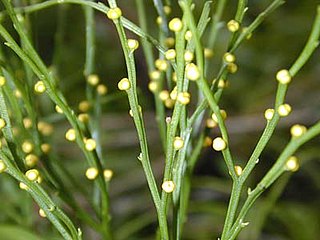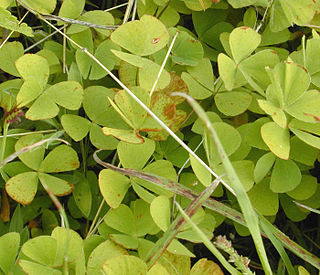
The ferns (Polypodiopsida or Polypodiophyta are a group of vascular plants that reproduce via spores and have neither seeds nor flowers. They differ from mosses by being vascular, i.e., having specialized tissues that conduct water and nutrients and in having life cycles in which the branched sporophyte is the dominant phase.

Azolla is a genus of seven species of aquatic ferns in the family Salviniaceae. They are extremely reduced in form and specialized, looking nothing like other typical ferns but more resembling duckweed or some mosses. Azolla filiculoides is one of just two fern species for which a reference genome has been published. It is believed that this genus grew so prolifically during the Eocene that it triggered a global cooling event that has lasted to the present.

The order Salviniales is an order of ferns in the class Polypodiopsida.

Salvinia, a genus in the family Salviniaceae, is a floating fern named in honor of Anton Maria Salvini, a 17th-century Italian scientist. Watermoss is a common name for Salvinia. The genus was published in 1754 by Jean-François Séguier, in his description of the plants found round Verona, Plantae Veronenses Twelve species are recognized, at least three of which are believed to be hybrids, in part because their sporangia are found to be empty.

Azolla filiculoides is a species of Azolla, native to warm temperate and tropical regions of the Americas which was introduced to Europe, North and sub-Saharan Africa, China, Japan, New Zealand, Australia, the Caribbean and Hawaii.

Azolla cristata , the Carolina mosquitofern, Carolina azolla or water velvet, is a species of Azolla native to the Americas, in eastern North America from southern Ontario southward, and from the east coast west to Wisconsin and Texas, and in the Caribbean, and in Central and South America from southeastern Mexico (Chiapas) south to northern Argentina and Uruguay.

Nymphaea mexicana is a species of aquatic plant that is native to the Southern United States and Mexico as far south as Michoacán. Common names include yellow waterlily, Mexican waterlily and banana waterlily.

Pistacia mexicana, also known as Mexican pistache, American pistachio or wild pistachio is a species of plant in the family Anacardiaceae found in Guatemala, Mexico, and the United States (Texas). It is threatened by habitat loss.

Nymphaea odorata, also known as the American white waterlily, fragrant water-lily, beaver root, fragrant white water lily, white water lily, sweet-scented white water lily, and sweet-scented water lily, is an aquatic plant belonging to the genus Nymphaea. It can commonly be found in shallow lakes, ponds, and permanent slow moving waters throughout North America where it ranges from Central America to northern Canada. It is also reported from Brazil and Guyana.

Cyperus acuminatus is a common species of sedge known by several common names, including tapertip flatsedge and pale umbrella-sedge. This plant is native to North America, where it is widespread across the Great Plains and the western United States, with scattered populations in the eastern US as well as in Saskatchewan, Tamaulipas and Coahuila.

Sabal mexicana is a species of palm tree that is native to far southern North America. Common names include Rio Grande palmetto, Mexican palmetto, Texas palmetto, Texas sabal palm, palmetto cabbage and palma de mícharos. The specific epithet, "mexicana", is Latin for "of Mexico."
Pilularia americana, the American pillwort, is an unusual species of fern. The fronds essentially consist of the petioles only, any form of flattened laminae having been lost. It is in the aquatic fern family Marsileaceae, and is related to the water clovers and also to Azolla and Salvinia.

Azolla pinnata is a species of fern known by several common names, including mosquitofern, feathered mosquitofern and water velvet. It is native to much of Africa, Asia and parts of Australia. It is an aquatic plant, it is found floating upon the surface of the water. It grows in quiet and slow-moving water bodies because swift currents and waves break up the plant. At maximum growth rate, it can double its biomass in 1.9 days, with most strains attaining such growth within a week under optimal conditions.

Samea multiplicalis, the salvinia stem-borer moth, is an aquatic moth commonly found in freshwater habitats from the southern United States to Argentina, as well as in Australia where it was introduced in 1981. Salvinia stem-borer moths lay their eggs on water plants like Azolla caroliniana, Pistia stratiotes, and Salvinia rotundifolia. Larval feeding on host plants causes plant death, which makes S. multiplicalis a good candidate for biological control of weedy water plants like Salvinia molesta, an invasive water fern in Australia. However, high rates of parasitism in the moth compromise its ability to effectively control water weeds. S. multiplicalis larvae are a pale yellow to green color, and adults develop tan coloration with darker patterning. The lifespan, from egg to the end of adulthood is typically three to four weeks. The species was first described by Achille Guenée in 1854.

Salvinia auriculata is a species of plant in the Salviniaceae known by the common names eared watermoss, African payal, and butterfly fern. It is native to the Americas from Mexico south to Argentina and Chile. It is cultivated as an ornamental plant and it has become naturalized in the wild in some places.

Salvinia minima is a species of aquatic, floating fern that grows on the surface of still waterways. It is usually referred to as common salvinia or water spangles. Salvinia minima is native to South America, Mesoamerica, and the West Indies and was introduced to the United States in the 1920s-1930s. It is classified as an invasive species internationally and can be detrimental to native ecosystems. This species is similar to but should not be confused with giant salvinia, Salvinia molesta.
Sagittaria demersa, commonly called Chihuahuan arrowhead, is an aquatic plant species native to north-central Mexico and also from a few sites in the northern part of the US State of New Mexico.

Sagittaria guayanensis, the Guyanese arrowhead, is an aquatic plant species. It is predominantly tropical, native to Mexico, Central America, the West Indies, and much of South America, as well as West Africa, south and southeast Asia, plus Sudan and Madagascar. It was unknown in the United States until a few populations were reported from Louisiana in 1969.

Argyrochosma limitanea, the southwestern false cloak fern, is a species of fern native to the southwestern United States and Sonora, Mexico. It grows on calcareous rocks, and has small, finely-divided leaves with a leathery texture, dark axes connecting the leaf segments, and a heavy coating of white powder on the undersurface. It reproduces apogamously; two subspecies are recognized, which may have originated independently through the hybridization of other taxa not yet discovered. First described as a species in 1919, it was transferred to the new genus Argyrochosma in 1987, recognizing their distinctness from the "cloak ferns".

Phyllanthus fluitans, also known as the red root floater, floating spurge, or apple duckweed is a species of free floating aquatic plant and herbaceous perennial in the family Phyllanthaceae. This species is one of the only three non-terrestrial species in the genus Phyllanthus, with the other species being P. leonardianus and P. felicis. The generic name comes from Ancient Greek meaning leaf or a leaf flower, and the specific name comes from Latin meaning floating or float. It was described in March 1863 by George Bentham and Johannes Müller Argoviensis.


















